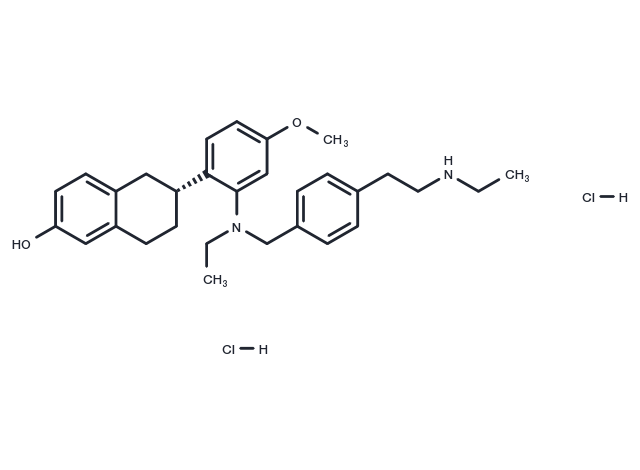Powder: -20°C for 3 years | In solvent: -80°C for 1 year


Elacestrant dihydrochloride (DA-DKRAD1901 dihydrochloride) is an orally available selective estrogen receptor degrader with IC50s of 48 for ERα and 870 nM for ERβ, respectively.

| Pack Size | Availability | Price/USD | Quantity |
|---|---|---|---|
| 1 mg | In stock | $ 122.00 | |
| 5 mg | In stock | $ 249.00 | |
| 10 mg | In stock | $ 396.00 | |
| 25 mg | In stock | $ 665.00 | |
| 50 mg | In stock | $ 947.00 | |
| 100 mg | In stock | $ 1,280.00 | |
| 1 mL * 10 mM (in DMSO) | In stock | $ 293.00 |


| Description | Elacestrant dihydrochloride (DA-DKRAD1901 dihydrochloride) is an orally available selective estrogen receptor degrader with IC50s of 48 for ERα and 870 nM for ERβ, respectively. |
| Targets&IC50 | ERβ:870 nM , ERα:48 nM |
| In vitro | Elacestrant exhibits inhibition of ERα expression in a dose-dependent manner, with an EC50 of 0.6 nM.?Treatment of ER-positive MCF-7 cells with E2 results in a potent and dose-dependent increase in proliferation, with an EC50 of 4 pM.?Treatment of cells with Elacestrant in the presence of 10 pM E2 results in a dose-dependent decrease in proliferation, with an IC50 value of 4.2 nM. Elacestrant selectively binds to and degrades the ER and is a potent antagonist of ER-positive breast cancer cell proliferation[1].? |
| In vivo | In MCF-7 xenograft models, Elacestrant-treated animals survived longer than those treated with either control or ICI 182780. RAD1901 preserves ovariectomy-induced bone loss and prevents the uterotropic effects of E2. Elacestrant produces a robust and profound inhibition of tumor growth in MCF-7 xenograft models[1].? |
| Synonyms | RAD1901 dihydrochloride |
| Molecular Weight | 531.56 |
| Formula | C30H40Cl2N2O2 |
| CAS No. | 1349723-93-8 |
Powder: -20°C for 3 years | In solvent: -80°C for 1 year
DMSO: 80 mg/mL (150.50 mM), Sonication is recommended.
H2O: 40 mg/mL (75.25 mM)
You can also refer to dose conversion for different animals. More
bottom
Please see Inhibitor Handling Instructions for more frequently ask questions. Topics include: how to prepare stock solutions, how to store products, and cautions on cell-based assays & animal experiments, etc.
Elacestrant dihydrochloride 1349723-93-8 Endocrinology/Hormones Estrogen/progestogen Receptor inhibit RAD-1901 Dihydrochloride Inhibitor Elacestrant Dihydrochloride RAD1901 Dihydrochloride Estrogen Receptor/ERR Elacestrant RAD 1901 Dihydrochloride RAD1901 RAD 1901 RAD-1901 RAD1901 dihydrochloride inhibitor
